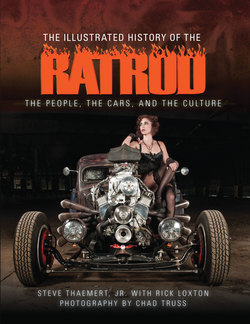Читать книгу The Illustrated History of the Rat Rod - Steve Thaemert Jr. - Страница 2
На сайте Литреса книга снята с продажи.
ОглавлениеIntroduction
There’s no question that rat rod culture is surrounded by a lot of “gray area.” For every fact, there seems to be a million opinions—opinions often formed through misperception or even bad information. And while this gray area sometimes creates confusion about what a rat rod is or where the term came from, it’s also part of the rat rod scene’s charm. Rat rods and the rat rod culture leave a lot of things open to interpretation. Some elements of the culture simply can’t be defined, while others are so subjective that they are entirely different for each person.
In this book, we’ll try to sort through the myths and get to the facts of what a rat rod is, what rat rod culture truly represents, and where this movement came from. I’ve written many articles in response to the question “what is a rat rod?” and I’ll probably write many more. It’s the question I’ve been asked most often throughout my tenure as editor of Rat Rod Magazine, and it’s the popular “pot-stirrer” in online forums. Want to get people talking? Ask them what a rat rod is. People naturally love to share their opinions, and their opinions are flavored by their own needs, ideas, and experiences.
Again, this is the charm—and possibly the biggest downer—of rat rod culture.
I’m not here to define anything. No single person or idea can do that. Only the community of builders and enthusiasts who collectively make up the rat rod scene can define exactly what a rat rod is. And even though people argue about and lobby for their own personal views on what a rat rod is, the culture tells us exactly what it is already: a rat rod is a blue-collar hot rod. Period.
Now, regarding that fact, there is a lot of room for interpretation, but the roots of rat rodding will always be deep in hot rod history. A rat rod is a form of hot rod, and the two cultures run parallel even today—maybe even more so today than in the past. The term “rat rod” may not have surfaced until the 1970s or ‘80s (no one really knows for sure), but the rat rod mentality has been around since the creation of the automobile. And, as with the automobile hobby, the terminology used in the rat rod hobby has changed over the years. What we considered a rat rod back in 1960 is much different from what we considered a rat rod in 1995, and both are much different from what we’d consider a rat rod today.
The automotive world is always evolving—cycling and recycling trends and fads, flowing alongside culture, living and dying and living again with each generation. The beauty of rat rod culture—and hot rod culture in general—is that it’s so rooted in American history that it endures. Its multigenerational appeal carries it from fathers to sons to grandsons, changing along the way
but never deviating too far from its foundations.
Preservation comes in many forms. In the automotive world, you have museum-quality restorations—which are an important part of history—all the way down to the daily driver. Yes, you can certainly drive a piece of history; in many cases, that is the best form of preservation because you are maintaining it and people are seeing the vehicle in motion in a very real way. The thing about expensive restorations is this: once you restore a vehicle, its original story is covered up forever. Take a faded ’33 Chevy sedan with all of the dents and scratches on its patina-laden body. Its story is there, in those imperfections. Maybe it has a bullet hole. Why is it there? Did it come from a couple of kids shooting targets in a field, or was this car used for a bank robbery, or … what? Patch it and paint it, and that mystery is gone. Same with old lettering or historic markings. Cover them up, and you can no longer see the story. In rat rodding, these imperfections are usually preserved. The story is left visible for each observer to interpret.
So, yes, the rat rod community is essentially preserving vehicles—albeit in an unorthodox manner. But doesn’t it make sense to leave some history alive in all of its distressed beauty? Time is an incredible artist. So is Mother Nature. They work in tandem in fascinating ways, not just on cars and trucks but on people and really everything around us. Rat rodding tends to capture that artwork and display it.
The exciting thing about today’s rat rod and hot rod scenes? You’re seeing cars from the 1930s and ‘40s and sometimes earlier that have sat for decades in scrap yards or in fields and have been resurrected and given new life. I think it’s fascinating that a seventy-five-year-old car can be patched together and driven around the country, with all of its history—its soul, if you will—preserved and passed on to a new generation. What a cool way to honor automotive history—by enjoying the very essence of the automobile: the drive itself.
Like Rat Rod Magazine has done since 2010, this book will take you on a visual journey into rat rod culture—from its roots to its modern manifestation.
